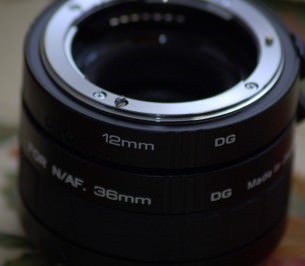 The world of macro photography is one of the most exciting to explore, but for high-quality results you'll find yourself digging deep into your pockets. Luckily there are several alternatives to buying a serious macro lens. Though they may not provide the same quality, they are all an excellent way to get introduced into macro photography and learn the technique.
The world of macro photography is one of the most exciting to explore, but for high-quality results you'll find yourself digging deep into your pockets. Luckily there are several alternatives to buying a serious macro lens. Though they may not provide the same quality, they are all an excellent way to get introduced into macro photography and learn the technique.
Macro Filters
These filters are among the easiest and cheapest solutions for macro photography. They screw into the front of your camera lens, just like any other filter, and work very similar to a magnifying glass. The filter allows you to focus closer to your subject with whatever lens you attach it too. These filters typically come in sets with different strengths, from +2 to +10. The stronger the filter, the more macro ability you will have, and you can even stack the filters.
The downside is the quality. You can pick up a set of these filters for about $15-20, and that's about what they're worth. They provide much less detail than a dedicated macro lens and aberrations are visible with the stronger filters. However, if you're on a tight budget, this is a good way to get into macro photography.
Recommended Cameras:
Nikon D500 | Nikon D3300 | Canon EOS Rebel T5 | Sony A7RII | Canon 7D Mark II
Extension Tubes
There are no optical elements present in extension tubes which means there is no degradation in quality. However, there is a loss of light. Extension tubes fit in between your camera and your lens. By increasing the distance from the camera to the lens, you decrease the minimum focusing distance. Like the filters, these tubes come in a set with different lengths which give you more or less macro ability.
Extensions tubes come in two types: those with electrical contacts and those without. Without the electrical contacts, autofocus and aperture control will be disabled for modern lenses. Those with electric contacts are also more expensive than the regular extension tubes, but worth it because you will want control over the aperture.
Reverse Lens
With a special adapter, you can mount your lens backwards on your camera. This is the best alternative to a macro lens in terms of quality and light loss, and depending on the lens you use, it can also give you the greatest magnification ratio. The wider your lens, the more macro ability it will have when reversed.
The downfall to this method is aperture control. On some lenses, you can use the aperture ring or adjust the lever on the back. On others, it may be very difficult or impossible to change the aperture while the lens is mounted backwards.
Teleconverters
If you have a nice telephoto lens, a teleconverter can give you the ability to take macro shots. A teleconverter simply extends the focal length of your lens. Typical TCs come in 1.4x, 1.7x and 2x. When a teleconverter is attached, it affects the focal length, but not the minimum focusing distance which, depending on your lens, could put you in the macro range.
Teleconverters vary in quality depending on brand, but they will typically show some loss in sharpness and may emphasize aberrations of your lens. There is also a greater loss of light the more powerful the TC is. The bonus to this method is that it is the only alternative that doesn't affect your ability to focus to infinity so you have the versatility of using it as a super telephoto or macro lens.
Recommended Reading:
- David Busch's Close-Up and Macro Photography Compact Field Guide
- Understanding Close-Up Photography: Creative Close Encounters with Or Without a Macro Lens
- Creative Close-Ups: Digital Photography Tips and Techniques
- Close-Up & Macro Photography (Expanded Guide: Techniques)
- Macro Photography for Gardeners and Nature Lovers
- Photographing Flowers: Exploring Macro Worlds with Harold Davis
Written by Spencer Seastrom
Image credit: kkzoli / 123RF Stock Photo

